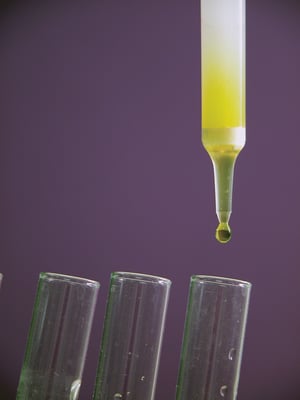 Affinity purification, also called affinity chromatography, is a laboratory technique used for purifying protein or protein complexes within a biochemical mixture. Unlike other chromatography-based purification methods which separate molecules based on size (i.e., gel filtration or size-exclusion chromatography) or strength of ionic interaction with a solid phase material (i.e., ion exchange chromatography), affinity purification works by manipulating certain molecular properties and specific binding interactions between molecules to purify the protein of interest.
Affinity purification, also called affinity chromatography, is a laboratory technique used for purifying protein or protein complexes within a biochemical mixture. Unlike other chromatography-based purification methods which separate molecules based on size (i.e., gel filtration or size-exclusion chromatography) or strength of ionic interaction with a solid phase material (i.e., ion exchange chromatography), affinity purification works by manipulating certain molecular properties and specific binding interactions between molecules to purify the protein of interest.
How Does It Work?
Basically, affinity purification works by manipulating the interaction strength differences between biomolecules in the mobile and stationary phases. As a complex mixture is passed over a solid support column, the ligand that is bound to the column will interact with the molecules that have a specific binding affinity to that particular ligand. As a result, the protein of interest is bound with the immobilized molecules while the undesirable molecules are eluted. Here’s how it works:
- The crude sample (cell lysate, serum, growth medium) or mobile phase is incubated with the stationary phase or affinity support (typically an agarose gel matrix or other porous resin) under conditions favoring the specific binding of the target molecule in the sample with the immobilized ligand.
Note: There are two ways by which ligands are immobilized to the solid support material. It can either be (1) through the formation of covalent bonds between particular functional groups (e.g., primary amines, aldehydes, carboxylic acids, sulfhydryls) and the reactive groups in the support or (2) through indirect coupling methods.
- An inhibitor containing a hydrocarbon chain is attached to the solid support to prevent overlap as the target molecules bind to the ligand. This acts as a spacer between the target molecule and the stationary phase.
- The undesirable non-target molecules are eluted with an appropriate wash buffer. Since the target molecules have a stronger affinity for the stationary phase, only the non-target molecules are washed away.
- The target molecules are then released from the immobilized ligand by using an elution buffer with a higher salt concentration, resulting in the recovery of a highly purified and concentrated material.
Note: By passing a cell lysate or serum sample through an affinity column, you can retrieve more than a thousand-fold of a particular protein so you’ll only be able to detect a single band after gel electrophoresis.
Affinity Purification Applications
Affinity chromatography techniques can be used in a number of ways, including the following:
- Immunoaffinity or the purification of antibodies from blood serum
- Immobilized metal ion affinity chromatography (IMAC)
- Purification of recombinant proteins
- Lectin affinity chromatography
- Boronate affinity chromatography
- Serum albumin purification
- Dye-ligand affinity chromatography
- Frontal analysis chromatography
- Analytical affinity chromatography
How to Get Accurate Results: Affinity Purification Best Practices
- Affinity medium should be thoroughly washed before use to remove all traces of storage solutions and preservatives.
- Always use high-quality water and chemicals.
- Unless you are working with identical samples, avoid reusing your affinity media.
- Magnetic stirrers can damage the matrix so use mild rotation or end-over-end stirring instead.
- Test the affinity of the ligand:target molecule interaction whenever possible since extremely low or high affinity will significantly reduce your yield.
- Adjust the sample to the composition and pH of the binding buffer to improve the binding efficiency of the target protein.
- Adjust the flow rate accordingly. Consider using high flow rates for interactions with strong ligand:target molecule affinity but use a lower flow rate for interactions with weak affinity and/or slow equilibrium.
- To improve the purity of the target molecule, make sure all unbound materials have been thoroughly washed through the column before proceeding with the elution of the bound target molecules.
- Perform a second technique (e.g., high-resolution gel filtration) after the affinity step to ensure that no aggregates or ligands have leached from the medium.






